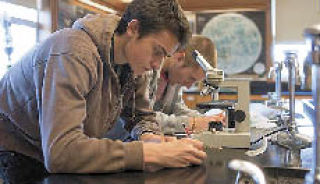Toshiba America Foundation announced an $11,075 grant to Lopez School for an innovative high school program in conservation genetics led by Madrona Murphy of the Lopez-based nonprofit laboratory Kwiáht. The Foundation awards a small number of grants each year to U.S. schools that involve their students in real research with advanced technologies.
It all began last year when Kwiáht arranged for the indefinite loan of an ABI 377 DNA sequencer from the University of Washington’s Friday Harbor Laboratories, to be housed and used at Lopez School. Lopez students Nia Bartolucci and Brooke Schober have been learning to operate the sequencer by studying genetic variation in cutthroat and Chinook salmon sampled last summer by Kwiáht biologists and local volunteers. High School principal Marc Vermeire encouraged Kwiáht to develop genetics activities for classroom learning as well as student projects after school hours. Kwiáht and the San Juan Nature Institute have been providing experiential science activities for Lopez School for the past five years including projects involving hydrology, marine ecology, sediments, and analytical chemistry.
Toshiba funds will be used by the school to purchase equipment and supplies for class sessions exploring bacterial diversity in garden soils and marine sediments, and identifying locally caught juvenile salmon by species and streams of origin from bits of fin tissue. Toshiba funds will also support senior projects applying molecular biology to conservation, such as estimating the size of rare animal populations, and determining whether rare animals in the San Juan Islands were recently introduced, or have been here for thousands of years.
Advanced students can join an after-school Molecular Ecology Club, which will study geographically isolated animal and plant populations in the San Juan Islands, such as the Island Marble butterfly, the San Juan Island flying squirrel, native cutthroat, and recently discovered Orcas fairy shrimp. The school genetics laboratory will eventually help pay for itself by documenting the islands’ genetically unique animals and plants, and supplying research data to federal and state resource managers.




